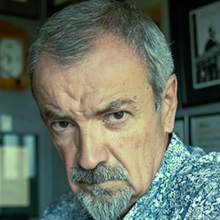En el humor, la crítica es muchas veces la ridiculización del poderoso
“Ermengol”, así firma sus obras el artista argentino-español Armengol Tolsà Badia, nacido en Canals, provincia de Córdoba en Argentina, pero residente en Lleida, España, desde 1985.
Es caricaturista, ilustrador, escultor; en fin, un creador multidisciplinar.
Ha trabajado en publicaciones importantes como El Jueves, Playboy, Segre y Diari d'Andorra. Ha sido director de la revista satírica La Quera y promotor de la asociación Humoràlia. Actualmente, publica sus chistes en el diario La Mañana, Núvol, Territoris, Borges Blanques, Almacelles, Vadefruita y esporádicamente en TV3. Dirige, además, la colección “Historia del Humor Gráfico en América Latina”. Y ha publicado libros como “Ermengolarium” y “RIP”. Ha participado en más de 30 exposiciones individuales y en colectivas en numerosos países.
En 1993 ganó el prestigioso Premio Mingote que otorga el diario ABC. Y este año recibió el reconocido Premio Notario del Humor, que otorga la Universidad de Alicante.
Por todo ese sustancioso curriculum, porque una vez lo entrevisté también aquí en este sitio, porque este año ganó un importante premio y porque disfruto sus caricaturas, lo tenemos con nosotros en este “diáloco”.
PP: Maestro, ¿siempre firmó sus obras como “Ermengol”? Cuando lo conocí, hace años, pensé que ese “gol” del nombre artístico tenía que ver con el fútbol, ya que nació en Argentina y vive en España, dos países campeones mundiales y muy futbolizados. Después supe que es un nombre catalán, algo así como Hermenegildo en castellano. Y a propósito, ¿cómo llegó al humor gráfico? ¿Desde muy pequeño? ¿Tuvo algo que ver que nació en tierra de humoristas como lo es Córdoba?
ERMENGOL: Me gusta mi nombre artístico Ermengol, aunque mi DNI dice Armengol, que era el nombre del padre de mi padre. Son muy frecuentes las bromas que me hacen sobre el GOL de mi nombre, pero creo que sería más justo que Messi se llamara Ermengol.
Llegué al humor desde niño, tener un párroco con sotana de director de la escuela dónde iba de pequeño fue un gran estímulo. Mis primeras “víctimas” fueron el propio cura y todas las personas que me rodeaban, principalmente maestros, profes, todo tipo de adultos que representaban poder o autoridad sobre mí. Haber nacido en Córdoba, Canals concretamente, supongo que alimentó este deseo de opinar satíricamente sobre lo que me provocaba.
PP: Pues lo ha hecho muy bien. ¿Y ha evolucionado su obra desde que comenzó hasta la actualidad? No me refiero a calidad, porque es obvio, con la experiencia, la superación, etc., esos cambios se dan obligatoriamente. Me refiero a si ha ido evolucionando en cuanto a forma y contenidos.
ERMENGOL: La evolución, tanto artística como periodística, es natural. No se ven igual las cosas con 15 años que con 30 o 50. El espíritu crítico y de análisis de lo que pasa en torno a mi vida es innato en mí. Cuando repaso dibujos míos publicados hace treinta o hace veinte años me producen incomodidad. Cómo pude haber hecho esto! Me digo para mí. Supongo que todos evolucionamos hasta el último día de vida, en todas las profesiones, salvo que seas fascista y eso se llama involución.
PP: A todos nos pasa. Sería bueno que pudiéramos hacer las mismas obras ahora, con la experiencia y compararlas. Buen ejercicio. Dígame una cosa: ¿es verdad la usada frase: "Es más fácil hacer llorar que hacer reír”?
ERMENGOL: Posiblemente sí. No he intentado nunca hacer llorar a nadie pero si hacer reír. Hacer reír inteligentemente es difícil. Conozco de gente que pretende hacer reír y hace llorar y otros que pretendes hacer llorar y hacen reír.
PP: Maestro, leí en su sitio ermengol.com que es humorista gráfico, caricaturista, etc. Mi pregunta es, ¿cree que la caricatura no entra en el humor gráfico? ¿Son dos modalidades diferentes?
ERMENGOL: En España se separan los conceptos humorista gráfico y caricaturista aunque el humor gráfico lleva de forma implícita la caricatura. Caricatura es la interpretación gráfica (muchas veces psicológica) de un rostro humano. Humor gráfico es una opinión satírica sobre una situación social, política, cultural, religiosa…
Me considero humorista gráfico y muy mal caricaturista.
PP: No me convence esa definición española. Para mí la caricatura sea personal o no, es una forma extrema de la parodia y ésta es una modalidad del humor. Y el humor gráfico las abarcas. Y que el humor gráfico sea solo una opinión satírica tampoco me satisface, porque el humor blanco y el humor que hace pensar sin ser sátira, realizada con dibujo, fotografía, etc., en un plano, también es humor gráfico. Pero no hay que preocuparse hay tantas definiciones como definidores, ya que nadie se pone de acuerdo, es un tema que necesita mucho estudio aún, ¿no es cierto? Bueno, entonces, si alguien del siglo X, por ejemplo, despierta ahora en el siglo XXI (como hacen en las películas de ciencia ficción), sin haber visto nunca en su vida una obra de humor gráfico en general y le preguntase a usted qué significa “humor gráfico”, ¿qué le diría como definición?
ERMENGOL: Le diría que el humor gráfico es opinión, es una crítica a lo que nosotros creemos modestamente que no funciona bien. Creo que esa es la esencia del humor, la crítica es muchas veces la ridiculización del poderoso, de aquel que hace mal desde su poltrona. El poder siempre ha de ser el objetivo de nuestra crítica. Ser elogioso con el poder te hace propagandista. Defiendo con todas mis fuerzas que los medios de comunicación tengan su espacio de humor gráfico, por incomodo que sea para sus responsables.
PP: De acuerdo, aunque con la ampliación a todo tipo de humor, como ya señalé. Ahora dígame, en una entrevista usted señaló que había que dignificar al humorista gráfico. ¿Cree que está pasando por un período indecoroso, vergonzoso para la profesión?
ERMENGOL: Creo que el humor gráfico vive desde hace tiempo en una situación de falta de reconocimiento público. No es indecoroso, ni vergonzoso, es una falta de protección por parte de la dirección de algunos medios ante las presión de los poderes políticos o económicos. Principalmente nosotros, los humoristas gráficos, debemos luchar por esta dignificación de esta profesión.
PP: De nuevo estamos de acuerdo y de nuevo lo ampliaría, de los poderes políticos o económicos (que supongo incluye a dictadores de derecha e izquierda), hasta el poder que están teniendo en la actualidad los fanatismos de todo tipo. ¿Y lo han censurado alguna vez por motivos ideológicos, económicos o por fanatismo de los políticamente correcto? ¿Se autocensura poco o mucho?
ERMENGOL: Muy pocas veces me autocensuro, me considero un dibujante prudente, conozco los límites de hasta dónde puedo llegar y no lo considero autocensura. He tenido la suerte de publicar en medios de comunicación que me han dado un buen margen de crítica. También sé que el fanatismo religioso no acepta muy bien el humor. En el tema político-económico he de decir que al poder no le gusta que le critiquen, ni que lo ridiculicen con una viñeta humorística
PP: Pregunta de moda. ¿cuáles serían los límites del humor, si cree que los hubiera?
ERMENGOL: Creo que los límites del humor los pone el sentido común. Los humoristas, los que hacemos crítica político-social, trabajamos desde la indignación que muchas veces se generan desde el poder o desde la acción de gobierno. Lo nuestro es denuncia de lo que creemos no han sido decisiones justas a una problemática social. Siempre debemos buscar la forma más inteligente de hacer esa denuncia gráfico-satírica. Nosotros tenemos más o menos claro cuáles son los límites, pero es importante que también los receptores de esa crítica tengan claro cuándo no es admisible ese comentario negativo. Sólo en esa falta de coincidencia en los límites puede generar un conflicto.
PP: Ojalá que los censuradores piensen así. Y partiendo de todo esto, ¿cómo ve el futuro del humor gráfico? ¿Internet es la solución ante tanta desaparición de espacios para publicar?
ERMENGOL: Quiero creer que el humor gráfico nunca desaparecerá. Estamos viviendo un momento de un descenso muy notable en el consumo de prensa escrita pero no veo, de momento, la desaparición total de los periódicos tal como los conocemos.
PP: Ojalá, pero hay colegas que son más pesimistas. Y otros creen que Internet es la solución. Y quizás lo sea, pero hay que resolver el problema del pago, ¿no es cierto? Bueno, cambio de rumbo, ¿le gustaría incursionar en algo dentro del humor que no haya hecho hasta ahora? ¿Tiene algún proyecto novedoso en mente?
ERMENGOL: He incursionado dentro del humor pero fuera del papel. Los proyectos Kayart y Bombones, por ejemplo, creo que tienen una carga humorística y satírica en algunos casos muy evidentes. Tengo algunas ideas que me rondan por la cabeza pero que hoy no explicaré porqué no están suficientemente maduras. Todas fuera del papel.
PP: Sí, sabía que es un creador “todo terreno” y espero que algún día, cuando se materialicen esas prometedoras ideas, nos avise para promocionarlas en Humor Sapiens. ¿Alguna anécdota relacionada con su profesión?
ERMENGOL: Explicaré una de varias que tengo. Es España tuvimos un presidente del gobierno conservador siniestro. Un espanto de tipo en lo personal y en lo ideológico. No acostumbro a sentir animadversión por nadie pero este personaje me producía una antipatía enfermiza. Un día me entero que en su despacho tenía un dibujo mío que le había gustado mucho. Me sentí desolado.
PP: Y para ir cerrando, ¿se le ocurre alguna pregunta que no le haya hecho y que le hubiese gustado que le hiciera? Si es así, ¿la puede responder ahora?
ERMENGOL: ¿El humor gráfico le ha permitido tener una vida sexo-afectiva más intensa que el resto de los mortales?
Ermen: Rotundamente NO! De joven confiaba que pudiera ser así pero resultó no ser cierto lo que me decían los viejos maestros del dibujo.
PP: Ja, ja… ¡Ojalá! Y para finalizar, Maestro, ¿le gustaría decirles unas palabras a nuestros seguidores de Humor Sapiens?
ERMENGOL: A los seguidores y amigos de Humor Sapiens les diría que reivindiquen espacios de humor en cada publicación impresa que les llegue a sus manos. Debemos exigir a los editores que incluyan humor en sus páginas si no lo tienen.
PP: Importantes palabras. Estimado Ermengol, ha sido un placer y un honor compartir ese “diáloco” con usted. Espero que lo haya disfrutado. Muchísimas gracias por su tiempo. Le deseo mucha salud y que sigan los éxitos.
ERMENGOL: ¡El placer es también para mí! Es una muy buena oportunidad para dirigirme a los seguidores de Humor Sapiens.
Y aprovecho para agradecer a Pepe Pelayo el hacer posible este medio. La gente vinculada a esta profesión debemos valorar la importancia de este medio. Un placer.
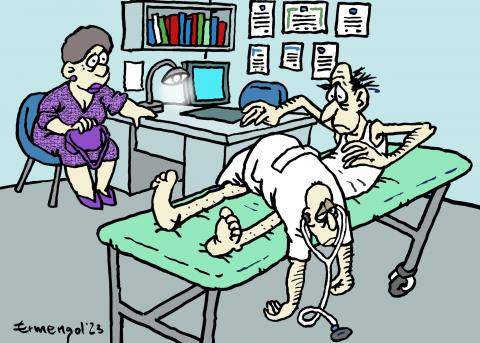
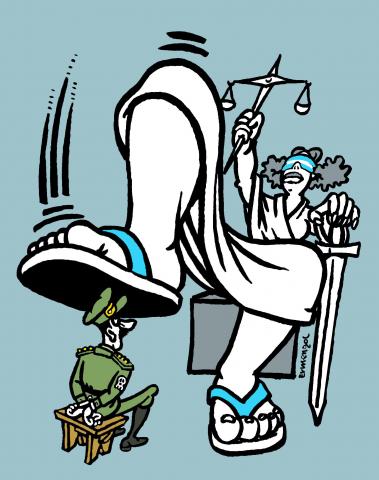
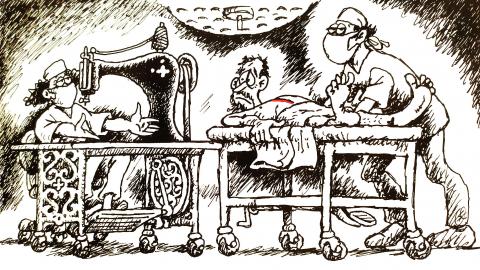
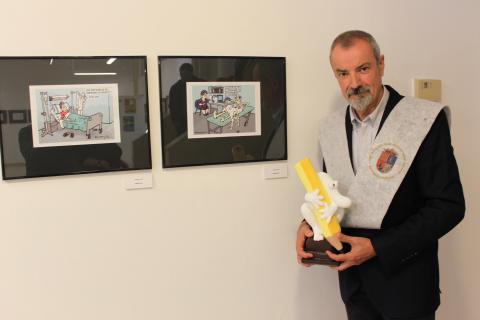
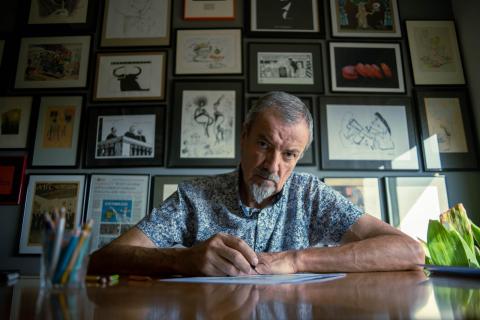
In humor, criticism is often the ridicule of the powerful
Interview with Ermengol
By Pepe Pelayo
“Ermengol”, is how the Argentine-Spanish artist Armengol Tolsà Badia, born in Canals, province of Córdoba in Argentina, but resident in Lleida, Spain, since 1985, signs his works.
He is a caricaturist, illustrator, sculptor; In short, a multidisciplinary creator.
He has worked in important publications such as El Jueves, Playboy, Segre and Diari d'Andorra. He has been director of the satirical magazine La Quera and promoter of the Humoràlia association. Currently, he publishes his jokes in the newspaper La Mañana, Núvol, Territoris, Borges Blanques, Almacelles, Vadefruita and sporadically on TV3. He also directs the collection “History of Graphic Humor in Latin America.” And he has published books such as “Ermengolarium” and “RIP”. He has participated in more than 30 individual and group exhibitions in numerous countries.
In 1993 he won the prestigious Mingote Prize awarded by the newspaper ABC. And this year he received the renowned Notary Award for Humor, awarded by the University of Alicante.
Because of all that substantial resume, because I once interviewed him here on this site, because this year he won an important award and because I enjoy his cartoons, we have him with us in this “dialogue.”
PP: Maestro, did you always sign your works as “Ermengol”? When I met him, years ago, I thought that “goal” in his stage name had to do with soccer, since he was born in Argentina and lives in Spain, two world champion countries with a lot of soccer. Later I learned that it is a Catalan name, something like Hermenegildo in Spanish. And by the way, how did you get into graphic humor? Since I was a child? Did it have anything to do with the fact that you were born in the land of comedians like Córdoba?
ERMENGOL: I like my stage name Ermengol, although my ID says Armengol, which was the name of my father's father. There are very frequent jokes made about the GOL of my name, but I think it would be fairer if Messi was called Ermengol.
I came to humor as a child, having a priest with a cassock as the director of the school where I went as a child was a great encouragement. My first “victims” were the priest himself and all the people around me, mainly teachers, professors, all types of adults who represented power or authority over me. Being born in Córdoba, Canals specifically, I suppose fueled this desire to give a satirical opinion about what provoked me.
PP: Well, he did it very well. And has your work evolved from when you began to the present? I am not referring to quality, because it is obvious, with experience, improvement, etc., these changes necessarily occur. I mean whether it has been evolving in terms of form and content.
ERMENGOL: Evolution, both artistic and journalistic, is natural. Things don't look the same at 15 years old as they do at 30 or 50. The critical spirit and analysis of what is happening around my life is innate in me. When I review my drawings published thirty or twenty years ago, they make me uncomfortable. How could I have done this! I say to myself. I suppose we all evolve until the last day of life, in all professions, unless you are a fascist and that is called involution.
PP: It happens to all of us. It would be good if we could do the same works now, with experience and compare them. Good exercise. Maestro, I read on your site ermengol.com that you are a graphic humorist, caricaturist, etc. My question is, do you think that caricature does not fall into graphic humor? Are they two different modalities?
ERMENGOL: In Spain, the concepts of graphic humor and caricaturist are separated, although graphic humor implicitly includes caricature. Caricature is the graphic interpretation (often psychological) of a human face. Graphic humor is a satirical opinion about a social, political, cultural, religious situation...
I consider myself a graphic humorist and a very bad caricaturist.
PP: I'm not convinced by that Spanish definition. For me, caricature, whether personal or not, is an extreme form of parody and this is a type of humor. And graphic humor covers them. And the fact that graphic humor is only a satirical opinion does not satisfy me either, because white humor and humor that makes you think without being satire, made with drawing, photography, etc., on one level, is also graphic humor. But don't worry, there are as many definitions as there are definers, since no one agrees, it is a topic that still needs a lot of study, right? Well, then, if someone from the 10th century, for example, wakes up now in the 21st century (as they do in science fiction movies), without having ever seen a work of graphic humor in general in their life, and asks you what It means “graphic humor”, what would you say as a definition?
ERMENGOL: I would tell you that graphic humor is opinion, it is a criticism of what we modestly believe does not work well. I think that is the essence of humor, criticism is often the ridicule of the powerful, of those who do evil from their armchair. Power must always be the objective of our criticism. Being complimentary of power makes you a propagandist. I defend with all my might that the media have their space for graphic humor, no matter how uncomfortable it may be for those responsible.
PP: Okay, although with the extension to all types of humor, as I already pointed out. Now tell me, in an interview you pointed out that the cartoonist had to be dignified. Do you think you are going through an unseemly, embarrassing period for the profession?
ERMENGOL: I think that graphic humor has been living in a situation of lack of public recognition for a long time. It is not indecorous or shameful, it is a lack of protection on the part of the management of some media in the face of pressure from political or economic powers. Mainly we, cartoonists, must fight for this dignity of this profession.
PP: Once again we agree and again I would expand it, from political or economic powers (which I suppose includes dictators from the right and left), to the power that fanaticisms of all kinds are currently having. And have you ever been censored for ideological, economic or politically correct fanaticism? Do you censor yourself a lot?
ERMENGOL: I very rarely censor myself, I consider myself a cautious cartoonist, I know the limits of how far I can go and I don't consider it self-censorship. I have been fortunate to publish in media outlets that have given me a good margin of criticism. I also know that religious fanaticism does not accept humor very well. On the political-economic issue I have to say that power does not like to be criticized, nor to be ridiculed with a humorous cartoon.
PP: Trendy question. What would be the limits of humor, if you think there were any?
ERMENGOL: I think the limits of humor are set by common sense. We comedians, those of us who make political-social criticism, work from the indignation that is often generated from power or from government action. Ours is a denunciation of what we believe have not been fair decisions regarding a social problem. We must always look for the most intelligent way to make that graphic-satirical complaint. We are more or less clear about what the limits are, but it is important that the recipients of that criticism are also clear when that negative comment is not admissible. Only in this lack of coincidence in the limits can a conflict arise.
PP: I hope the censors think like that. And based on all this, how do you see the future of graphic humor? Is the Internet the solution to so much disappearance of spaces to publish?
ERMENGOL: I want to believe that graphic humor will never disappear. We are experiencing a very notable decline in the consumption of the written press but I do not see, at the moment, the total disappearance of newspapers as we know them.
PP: Hopefully, but there are colleagues who are more pessimistic. And others believe that the Internet is the solution. And maybe it is, but the payment problem has to be solved, right? Well, change of course, would you like to venture into something within humor that you haven't done until now? Do you have any new projects in mind?
ERMENGOL: I have ventured into humor but outside of paper. The Kayart and Bombones projects, for example, I think have a humorous and satirical charge in some very obvious cases. I have some ideas that are running through my head but I will not explain today why they are not mature enough. All off paper.
PP: Yes, I knew that he is an “all-terrain” creator and I hope that one day, when those promising ideas materialize, he will let us know to promote them on Humor Sapiens. And to close, can you think of any questions that I haven't asked you and that you would have liked me to ask you? If so, can you answer it now?
ERMENGOL: Has graphic humor allowed you to have a more intense sexual-affective life than the rest of us?
Ermen: Absolutely NO! When I was young I trusted that it could be like that but it turned out that what the old drawing masters told me was not true.
PP: Ha ha… I wish! And finally, Master, would you like to say a few words to our followers of Humor Sapiens?
ERMENGOL: I would tell the followers and friends of Humor Sapiens to claim spaces for humor in every printed publication that comes into their hands. We must demand that editors include humor in their pages if they don't have it.
PP: Important words. Dear Ermengol, it has been a pleasure and an honor to share that “dialogue” with you. I hope you enjoyed it. Thanks a lot for your time. I wish you good health and continued success.
ERMENGOL: The pleasure is for me too! It is a very good opportunity to address the followers of Humor Sapiens.
And I take this opportunity to thank Pepe Pelayo for making this medium possible. People linked to this profession must value the importance of this medium. A pleasure.
(This text has been translated into English by Google Translate)

